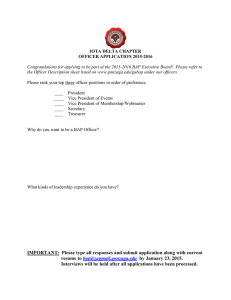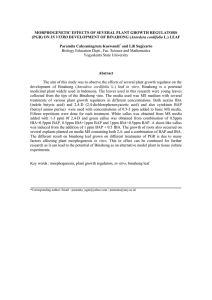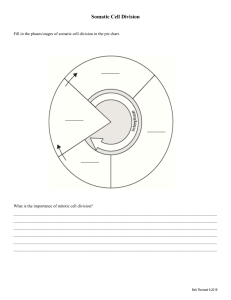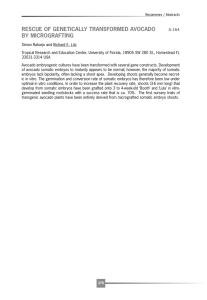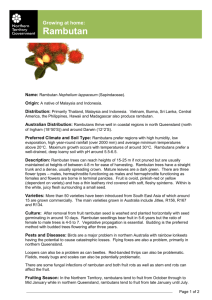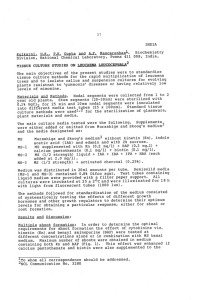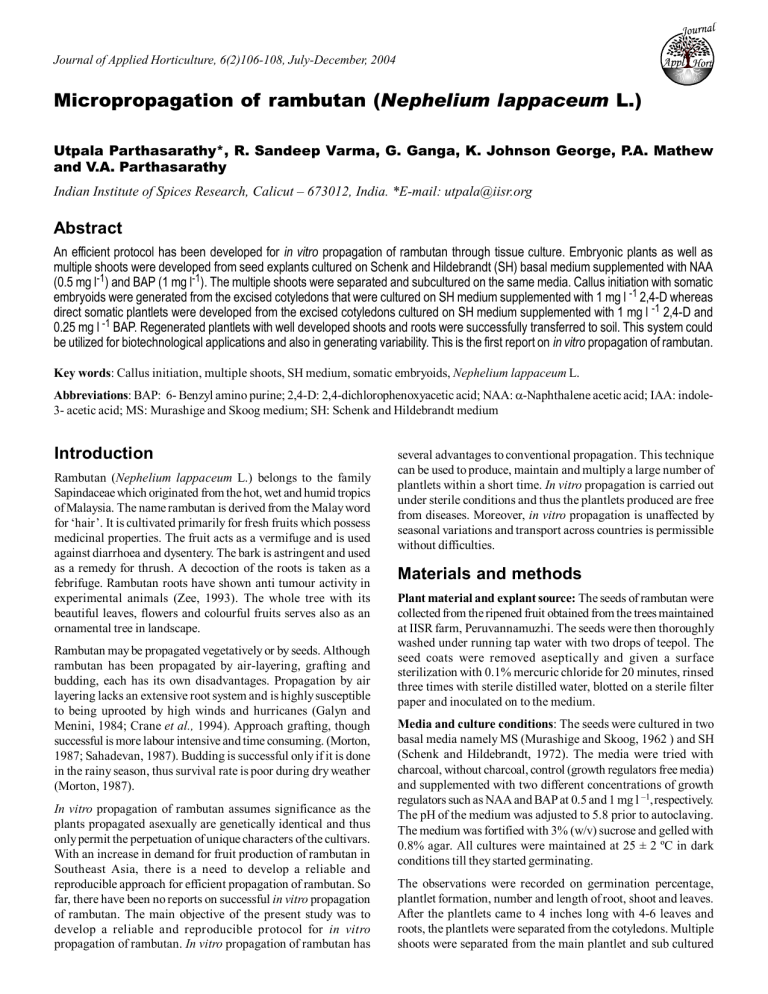
Journal of Applied Horticulture, 6(2)106-108, July-December, 2004 Micropropagation of rambutan (Nephelium lappaceum L.) Utpala Parthasarathy*, R. Sandeep Varma, G. Ganga, K. Johnson George, P.A. Mathew and V.A. Parthasarathy Indian Institute of Spices Research, Calicut – 673012, India. *E-mail: utpala@iisr.org Abstract An efficient protocol has been developed for in vitro propagation of rambutan through tissue culture. Embryonic plants as well as multiple shoots were developed from seed explants cultured on Schenk and Hildebrandt (SH) basal medium supplemented with NAA (0.5 mg l-1) and BAP (1 mg l-1). The multiple shoots were separated and subcultured on the same media. Callus initiation with somatic embryoids were generated from the excised cotyledons that were cultured on SH medium supplemented with 1 mg l -1 2,4-D whereas direct somatic plantlets were developed from the excised cotyledons cultured on SH medium supplemented with 1 mg l -1 2,4-D and 0.25 mg l -1 BAP. Regenerated plantlets with well developed shoots and roots were successfully transferred to soil. This system could be utilized for biotechnological applications and also in generating variability. This is the first report on in vitro propagation of rambutan. Key words: Callus initiation, multiple shoots, SH medium, somatic embryoids, Nephelium lappaceum L. Abbreviations: BAP: 6- Benzyl amino purine; 2,4-D: 2,4-dichlorophenoxyacetic acid; NAA: a-Naphthalene acetic acid; IAA: indole3- acetic acid; MS: Murashige and Skoog medium; SH: Schenk and Hildebrandt medium Introduction Rambutan (Nephelium lappaceum L.) belongs to the family Sapindaceae which originated from the hot, wet and humid tropics of Malaysia. The name rambutan is derived from the Malay word for ‘hair’. It is cultivated primarily for fresh fruits which possess medicinal properties. The fruit acts as a vermifuge and is used against diarrhoea and dysentery. The bark is astringent and used as a remedy for thrush. A decoction of the roots is taken as a febrifuge. Rambutan roots have shown anti tumour activity in experimental animals (Zee, 1993). The whole tree with its beautiful leaves, flowers and colourful fruits serves also as an ornamental tree in landscape. Rambutan may be propagated vegetatively or by seeds. Although rambutan has been propagated by air-layering, grafting and budding, each has its own disadvantages. Propagation by air layering lacks an extensive root system and is highly susceptible to being uprooted by high winds and hurricanes (Galyn and Menini, 1984; Crane et al., 1994). Approach grafting, though successful is more labour intensive and time consuming. (Morton, 1987; Sahadevan, 1987). Budding is successful only if it is done in the rainy season, thus survival rate is poor during dry weather (Morton, 1987). In vitro propagation of rambutan assumes significance as the plants propagated asexually are genetically identical and thus only permit the perpetuation of unique characters of the cultivars. With an increase in demand for fruit production of rambutan in Southeast Asia, there is a need to develop a reliable and reproducible approach for efficient propagation of rambutan. So far, there have been no reports on successful in vitro propagation of rambutan. The main objective of the present study was to develop a reliable and reproducible protocol for in vitro propagation of rambutan. In vitro propagation of rambutan has several advantages to conventional propagation. This technique can be used to produce, maintain and multiply a large number of plantlets within a short time. In vitro propagation is carried out under sterile conditions and thus the plantlets produced are free from diseases. Moreover, in vitro propagation is unaffected by seasonal variations and transport across countries is permissible without difficulties. Materials and methods Plant material and explant source: The seeds of rambutan were collected from the ripened fruit obtained from the trees maintained at IISR farm, Peruvannamuzhi. The seeds were then thoroughly washed under running tap water with two drops of teepol. The seed coats were removed aseptically and given a surface sterilization with 0.1% mercuric chloride for 20 minutes, rinsed three times with sterile distilled water, blotted on a sterile filter paper and inoculated on to the medium. Media and culture conditions: The seeds were cultured in two basal media namely MS (Murashige and Skoog, 1962 ) and SH (Schenk and Hildebrandt, 1972). The media were tried with charcoal, without charcoal, control (growth regulators free media) and supplemented with two different concentrations of growth regulators such as NAA and BAP at 0.5 and 1 mg l –1, respectively. The pH of the medium was adjusted to 5.8 prior to autoclaving. The medium was fortified with 3% (w/v) sucrose and gelled with 0.8% agar. All cultures were maintained at 25 ± 2 ºC in dark conditions till they started germinating. The observations were recorded on germination percentage, plantlet formation, number and length of root, shoot and leaves. After the plantlets came to 4 inches long with 4-6 leaves and roots, the plantlets were separated from the cotyledons. Multiple shoots were separated from the main plantlet and sub cultured Micropropagation of rambutan (Nephelium lappaceum L.) on the same media. The plantlets were later transferred into liquid SH medium with NAA and BAP at the same concentration. The cotyledons were cut into 2 pieces and inoculated into the culture media (MS and SH medium), supplemented with 1 mg l –1 2,4-D and also with 1 mg l –1 2,4-D and BAP with two different concentrations (0.25 and 0.5 mg l–1 respectively) for callus induction. Plant acclimatization: After the plants developed good root system in the liquid media, they were transferred in to the pots containing sterile coir dust. Initially the plantlets were covered with perforated polythene bag. Gradually the bags were removed completely. After successful establishment in coir dust, they were transferred to small plastic pots filled with garden soil and kept in a green house for further growth. Results and discussion The results are presented in the Table 1. It has been noticed that in the SH media containing 1 mg l–1 BAP and 0.5 mg l–1 NAA, the growth was the best and multiple shoots were developed (Fig. 1a). The multiple shoots were separated from the cotyledon and subcultured on the same media. In the SH media with 0.5 mg l–1 BAP and 0.5 mg l–1 NAA, germination started but the percentage of germination was not good enough. Though the plantlets exhibited good numbers of roots and leaves, multiple shoots were not formed. After separating the cotyledons from the plants, the cotyledons were cut and inoculated in SH medium supplemented with 2,4D (1 mg l–1). It was observed that callus formation initiated from the cotyledon explants (Fig. 1d). It was also noticed that the SH medium containing 2,4-D (1 mg l–1) produced white friable callus with somatic embryoids (Fig. 1e). In SH medium supplemented with 2,4-D (1 mg l–1) and BAP (0.25 mg l–1), direct somatic plantlets were obtained (Fig. 1f). Efforts have been made to develop a suitable protocol for micropropagation and regeneration of rambutan. Rambutan is a Table 1. Morphogenetic effect of media and supplementation Media Growth Generation percentage time MS (with no growth regulators) No growth –1 MS + BAP (1mg l ) + No growth NAA (1mg l –1) without charcoal SH + BAP (1mg l –1) + 80% NAA (1mg l –1) without charcoal SH (with no growth regulators) No growth SH + BAP (0.5 mg l –1) + 100% NAA (0.5 mg l –1) with charcoal SH medium + BAP (1mg l –1) + 100% NAA (0.5mg l –1) with charcoal Trials for callus formation from the cotyledon explants SH medium+ 2,4-D (1mg l –1) + 100% 1.5% charcoal SH medium+ 1.5% charcoal + 100% BAP (0.25mg l –1) + 2,4-D (1mg l –1) * = after 45 days 107 member of the Sapindaceae family but the tissue culture protocols available on other important members of the family like litchi (Das et al., 1999) and longan (Litz, 1988) were not successful for the micropropagation of rambutan. The results obtained showed that SH media with charcoal gives 100% germination when compared to MS medium with or without charcoal where germination started but never developed into plantlets. It was also noticed that in SH media without charcoal the growth was inhibited, due to excess tannin secretion. Thus presence of activated charcoal in the medium was found to be important as it absorbed the unwanted exudates secreted in to the media. Presence of activated charcoal promotes morphogenesis, embryogenesis and root formation in plants (George, 1993). MS medium contains very high concentration of ammonium, calcium chloride, zinc and iron when compared to SH medium. Nitrates make the medium more alkaline (Parthasarathy and Parthasarathy, 2002). It has been reported that in Pinus strobus the adventitious shoot formation was better in SH medium when compared to MS medium due to the difference in ammonium levels of the two media (Flinn and Webb, 1986). Proper ammonium /nitrogen balance stimulates morphogenesis and embryogenesis (Parthasarathy and Parthasarathy, 2002). High concentration of calcium inhibits somatic embryogenesis and was found to be toxic to some woody plants (Parthasarathy and Parthasarathy, 2002). This might be the reason that the proper germination was not obtained in MS media. The present study also revealed that SH media is useful in callus formation and somatic plantlet formation. Studies made by Schenk and Hildebrandt (1972) in different plant species showed that SH medium is better for callus growth and somatic embryogenesis. The use of SH medium in organogenesis and somatic embryogenesis has been reported in black pepper (Nair and Dutta, 2003) and Orchard grass (Brittain et al., 1998). The effect of BAP on multiple shoot induction was studied. The SH medium containing 0.5 mg l –1 NAA and different concentrations of BAP at 0.2, 0.5 and 1 mg l–1, respectively were Length of shoot* Number of roots* Number of leaves* - Mean number of shoots/ multiple shoots* Nil Nil - - - 10 days 1 5 cm - - Nil - - - 10 days 1 24 cm 6 6 14 days 1/ 2 18 cm 4 5 35–40 days Callus formation - - - 35-40 days Somatic plantlet formation 6 cm - 5 108 Micropropagation of rambutan (Nephelium lappaceum L.) micropropagated plants are of immense importance in obtaining disease free plants. In vitro propagation enables genetic manipulation, which would be impossible when no methods for regenerating protoplasts, cells and tissues exist. The procedure outlined here should be useful not only for obtaining substantial supply of high quality plants but also for long term conservation of genotype for future biotechnological improvements. Acknowledgements We thank Mr. Sudhakaran for taking and arranging the photographs. References Fig. 1. Plant regeneration from seed and cotyledon explants of rambutan. a) Embryonic and multiple shoot regeneration from the seed explants after 2 weeks of culture, b) Plantlet separated from the cotyledon and cultured on SH solid medium, c) Plantlet transferred to liquid SH medium from solid medium after 2 weeks of culture, d) Callus initiation from the excised cotyledon after a 5 week culture on callus induction medium, e) White friable callus with somatic embryoid formation and f)Direct regeneration of somatic plantlet from the excised cotyledon after 5 weeks of culture tried. The increase in multiple shoot number was noticed in SH medium containing BAP at a concentration of 1 mg l–1. The role of BAP in prolific shoot multiplication was observed by Hazarika et al. (1996) in Bael (Aegle marmelos L.), where maximum number of elongated shoots were observed in medium supplemented with BAP at a concentration of 0.5 mg l–1. The effect of BAP on shoot multiplication in citrus has been reported by Parthasarathy et al. (2002) where the number of shoots was found to be maximum in higher concentration of BAP (0.75 mg l–1). Though the protocol outlined here may not be directly useful for clonal propagation, it has several biotechnological applications. Since, crop improvement by conventional methods is quite laborious and time consuming, in vitro propagation would be useful in creating genetic variability and also in improvement of cultivars through transfer of desirable genetic traits. This is the first report based on in vitro organ culture of rambutan. In vitro propagation of rambutan may prove as a rich and novel source of creating genetic variability with a great potential without resorting to mutation or hybridization. Since rambutan is affected by diseases like powdery mildew and stem canker, Brittain, H.L., S.R. Bowely and B.D. Mckersie, 1998. Callus concentration regulates somatic embryo production in orchard grass suspension cultures. In vitro Cell Dev. Biol- Plant., 34: 281-285. Crane, J., C. Balerdi, R. Campbell, C. Campbell and S. Goldweber, 1994. Managing fruit orchards to minimize hurricane damage. HortTech., 4: 21-27. Das, D.K., N.S. Prakash and N. Bhalla-Sarin, 1999. Multiple shoot induction and plant regeneration in litchi (Litchi chinensis Sonn.). Plant Cell Rep., 18: 691-695. Flinn, B. and B.T. Webb, 1986. Effects of media components and the timing of cytokinin application on caulogenisis from Pinus strobus embryogenic explants. In: Proc. Intl. Cong. Plant Tissue & Cell Culture, (pp. 36). Minneapolis, Minn. Galyn, S.V. and U.G. Menini, 1984. Litchi cultivation. FAO. Plant Production and Protection paper No. 83, Food and Agricultural Organisation, Rome. George, E.F. 1993. Plant Propagation by Tissue Culture Part 1: The Technology. Exegetics Ltd. England. Hazarika, B.N., V. Nagaraju and V.A. Parthasarathy, 1996. Morphogenetic response of Bael (Aegle marmelos L.) microshoots to benzyl amino purine. Ann. Plant Physiol., 10: 40-44. Litz, R.E. 1988. Somatic embryogenesis in longan (Dimocarpus longan Lour). J . Plant Physiol., 132: 190-193. Morton, J.F. 1987. Fruits of warm climates. Miami. Pp 137-145. Murashige, T. and F. Skoog, 1962. A revised medium for rapid growth and bioassay with tobacco tissue cultures. Physiol Plant., 15: 473497. Nair, R.R. and G.S. Dutta, 2003. Somatic embryogenesis and plant regeneration in black pepper (Piper nigrum L.) from tissues of germinating seeds and ontogeny of somatic embryogenesis. J. Hort. Sci. Biotech., 78: 416-421. Parthasarathy, V.A., A. Barua, V. Nagaraju and U. Parthasarathy, 2002. Effect of cytokinins on morphological, physiological and biochemical characteristics of shoots of citrus in vitro. Fruits, 57: 153-160. Parthasarathy, V.A. and U. Parthasarathy, 2002. Techniques and precautions for successful tissue culture. In: Aravind MD and Manuel LM (ed). Principles and techniques for Plant Scientists, (pp. 291-305). Updesh Purohit for Agrobios (India), Jodhpur. Sahadevan, N. 1987. Greenfingers. Sahadevan Publications, Malaysia. Schenk, R.U. and A.C. Hildebrandt, 1972. Medium and techniques for induction and growth of monocotyledonous and dicotyledonous plant cell cultures. Can. J. Bot., 50: 199-204. Zee, F.T. 1993. Rambutan and pili nuts: Potential crops of Hawaii. In: Janick J. and Simon J.E. (ed) Proceedings of the 2 nd National Symposium New Crops: Exploration, Research and Communication. 6-9 October 1991, Indianapolis, Indiana (pp. 461-465). Wiley, New York.
